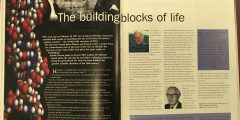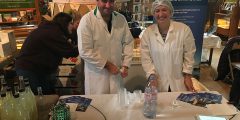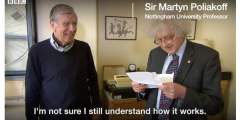70 Years on the University marks its role in the DNA discovery story
November 13, 2017
The discovery of hydrogen bonds in DNA was made by a young Nottingham Post Graduate student, J. Michael Creeth, in what was known as the Nucleic Acid Laboratory at (the then) University College Nottingham. The results were published in the Journal of the Chemical Society on 1947. The discovery paved the way for the double …
Nottingham remembers its part in the DNA discovery
November 9, 2017
Tomorrow the University of Nottingham celebrates the 70th anniversary of the discovery by a young PhD student, J Michael Creeth, of hydrogen bonds in DNA. The event will be attended by leading academics in the field. Fifteen years ago the scientific community celebrated the 50th anniversary of the discovery of DNA by Crick and Watson. …
ESRC annual celebration of social sciences
October 31, 2017
Academics from University of Nottingham will be playing a major part in this year’s annual festival of social science from the 4-11 November. Now in its 15 year, the Economics and Social Research Council (ESRC) festival will see 316 events across the UK, taking the social sciences to diverse and new audiences covering a range …
The ‘taste’ of Bramley apple juice is put to the test
October 25, 2017
Volunteers were more than happy to offer their services this weekend when they were asked to give their opinion on which variety of Bramley apple juice tastes the best and why. Many of the hundreds of visitors to this year’s Bramley Apple Festival in Southwell were asked to participate in the blind tasting set up …
Keeping schtum – the unsolved secret of David Jones’ perpetual motion machine
October 18, 2017
Professor Sir Martyn Poliakoff, long standing friend and academic colleague of the late David Jones, has vowed to keep his best kept secret – how his famous perpetual motion machine works. This week Sir Martyn was filmed by the BBC’s Inside Out team opening the brown envelope left by David Jones in his will to …
Yesterday’s ‘red sky’ seen at the microscale
October 17, 2017
Images of particles from yesterday’s ‘red sky’ have been produced at the microscale by University of Nottingham geologist Dr Beth Steer. The particles, collected from her car after the dust was rained out of the atmosphere were put under a scanning electron microscope using energy dispersive x-ray spectrometry to detect elemental abundances. Having analysed the samples …
The Ada Lovelace effect
October 9, 2017
The Ada Lovelace effect Ada Lovelace, the ‘Countess of Computing’, was born in London on 10 December 1815. The daughter of Lord Byron, Ada Lovelace was a gifted mathematician recognised for creating the first computer programme and forseeing a digital future. Every year scientists across the world mark Ada Lovelace Day – which is being …
The SS Thistlegorm: Bringing the sunken secrets of WWII to the surface
October 6, 2017
A new website will let people explore one of the world’s most famous diving sites on their phones or home computers thanks to a 3D virtual reality project. The new website, which launches on Friday 6 October, will give visitors the chance to explore the wreckage of the SS Thistlegorm, a British merchant steam ship …
The 3D selfie is here!
September 26, 2017
Computer scientists at the University of Nottingham and Kingston University have solved a complex problem that has, until now, defeated experts in vision and graphics research. They have developed technology capable of producing 3D facial reconstruction from a single 2D image – the 3D selfie. Their new web app allows people to upload a single …
More than 40 million people are trapped in slavery across the globe: shocking new figures reveal the true scale of modern slavery.
September 21, 2017
A Nottingham slavery expert has contributed to research published on Tuesday (19 September 2017) revealing that there are 40 million victims of modern slavery and 152 million in child labour around the world. The research was developed jointly by the International Labour Organization (ILO) and the Walk Free Foundation, in partnership with the International Organization …










